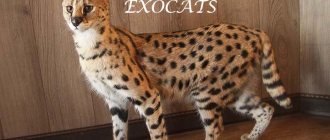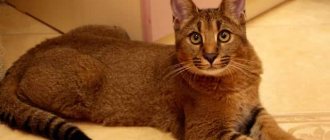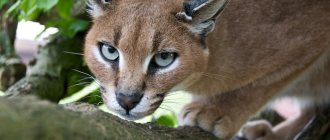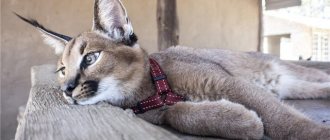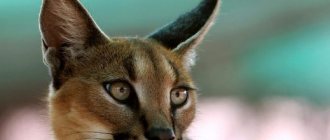- Posted by Olga Arkhipova
- Date: March 21, 2018
Caracals are predators of the cat family, distinguished by long black tufts on their ears. These are very capricious and demanding animals. However, with proper care and caring attitude, desert cats will become loyal and devoted friends to their owners.
- 2 Where does the caracal live
2.1 Video: caracal
- 3.1 Video: caracal hunting
- 4.1 Video: caracal at home
Why was the caracal called that?
Fast and hardy animals, caracals are distinguished by their unusual appearance due to the long dark tufts of hair on their ears. The literal translation of the name of these representatives of the cat family from Turkish means “black ears.” Externally, caracals are similar to the common lynx. Common features of these animals include wide paws and round pupils. But, unlike the lynx, the steppe cat has a long tail.
Caracal is the closest relative of the common lynx
Other characteristic features of the caracal's appearance are:
- slim body weighing no more than 20–24 kg;
- compact dimensions of the body - the height at the withers is on average 40 cm, and the body length reaches a maximum of 100 cm;
- long tail - in adult individuals, the size of this part of the body varies from 24 to 31 cm;
- short coat with a thick undercoat, moderately hard to the touch;
- a small graceful head with an elongated muzzle, on which patches of black fur are noticeable on the sides and near the eye sockets;
- elongated paws, capable of overcoming sand dunes thanks to the hard bristles on the outside of the hands;
- a short mustache next to a large black nose, the latter highlighted by pinkish pigment in the central part;
- high (up to 4–5 cm) pointed ears with long black sickle-shaped tassels;
- monochromatic color with a predominance of sandy shades (from light beige to reddish), alternating with white (on the belly, throat, chin and inside the ears) and black (outer part of the ears) fur.
Otherwise, caracals are called desert or steppe lynxes. This is due to the animal’s distribution area - the deserted shores of the Caspian and Red Seas, the steppes of Turkmenistan and Dagestan, the plateaus of Turkey and Iran.
In former times, such predators were not uncommon in those parts and were tamed to hunt small ungulates and hares.
To this day, African caracals do not need protection, which cannot be said about their Asian counterparts. The latter are reducing their numbers every year, which is why they were listed in the Red Book.
Description of the breed
Externally, caracals are very similar to lynx, but have a more compact size. They reach a length of up to 85 cm. The weight of an adult is from 16-19 kg, but there are especially large representatives that weigh up to 25 kg. These cats have very expressive eyes and a long, mobile tail. Caracals are strikingly colored in all shades of brown, from sandy gold to rich dark brown, with several light spots on the face.
By nature, such cats are very capricious, therefore, it is better to buy a kitten raised in a nursery and accustomed to communicating with people. A caracal that grows up among people becomes very sociable and friendly with its owners and loves to play. Such a pet will practically not meow. He shows his emotions by growling or purring.
Such pets shed throughout the year, most actively in the summer.
Where does the caracal live?
Despite the telling name, these cats can be found not only among sand dunes and steppe feather grasses. Caracals live in forests and foothills. A flexible body and elastic paws allow steppe lynxes to deftly climb trees. From there you have a wide view of the conquered territories. By the way, their area can reach 340 km2 or more.
Caracals, like other cats, deftly climb trees.
To rest, the caracal prefers to look for holes or crevices in the rocks abandoned by other animals. If the animal likes the place, the desert lynx will return to such a refuge for many years.
It is noteworthy that males and females live separately, meeting only during mating and having offspring.
By nature, these animals are loners. Having reached sexual maturity in the first year of life, the caracal leaves its fellows to conquer its own territory.
Video: caracal
History of the origin of the breed
The Caracal cat breed originated in ancient times. It was believed that hunters from Africa and Central Asia went out hunting, taking a wild cat as a companion. And while wealthier people could afford cheetahs, the caracal was considered a more economical option. By the way, even today in many areas people among themselves call these animals “cheetahs for the poor.”
At the same time, the hunting instincts of caracals have always been at their best. Such cats could catch a pheasant, peacocks, a hare or even an antelope. Currently, caracals mostly live in the wild. There really aren’t that many domesticated purrs.
The name of the breed comes from the phrase “black ear” (from the Turkic language).
The breed was recognized as a domestic caracal only in the 20th century. It was then that he entered Europe. Recently, this breed has been officially recognized by all felinological organizations and has certain standards.
Lifestyle of the steppe lynx
The life of a wild caracal kitten begins after 75–80 days of the female's pregnancy. As a rule, there are no more than three cubs in a litter. The litter is born blind, and only two weeks later the kittens begin to see. Until this moment, the female jealously guards the offspring, hidden in a gorge or an abandoned hollow of a fallen tree.
Female steppe lynx are caring and zealous mothers
The color of caracal cubs differs from the appearance of adult individuals due to the large number of dark specks on their fur. Over time, only the muzzle remains spotted.
A month after birth, the kittens begin to develop the territory near the den, and after another month the female transfers the babies to solid food.
Regarding the latter, it is worth noting the following:
- Caracals feed mainly on small rodents and birds like guinea fowl;
- Steppe lynxes forage for food at night;
- These animals hunt, reaching prey with the help of large jumps (up to 5 meters in length) or waiting at watering holes;
- These cats make caches of food high in the trees.
Since the animal is accustomed to life in arid areas, the caracal can go without drinking for a long time - for up to ten days, this cat is able to obtain liquid only from food. In this case, the diet of the desert lynx is expanded by including grass and berries (for example, grapes) in the menu.
Caracals are dexterous and intelligent predators, skillfully camouflaging themselves among thickets of bushes. So these animals have few enemies. The main threat comes from birds of prey during the period of raising their offspring. And for adult individuals, lions and hyenas become enemies if the animal lives in African savannas, or steppe wolves and alabai guarding sheep (when it comes to Kazakh or Turkmen steppe lynxes).
Hunting for caracal is prohibited in the countries of the former USSR, since the species is on the verge of extinction. At the same time, these animals do not take root in zoos. Therefore, nature reserves and sanctuaries are organized in the habitats of desert lynxes.
However, local residents often engage in poaching of steppe lynx due to the threat of a reduction in livestock numbers.
Video: caracal hunting
Population and species status
To date, there is no accurate data on the number of caracals in the wild, so it is almost impossible to give an accurate assessment of the population status of these living creatures. In Asia and northern Africa, these predators are considered rare, but in the south and center of the African continent, caracals are considered problem animals, so they can be hunted at any time of the day or night. Ranchers sometimes leave behind poisoned animal carcasses, which kills many predators.
In South Africa, an average of 2,200 caracals were killed between 1931 and 1952, while in Namibia almost 3 thousand individuals were killed in 1981 alone.
Important factor! Recently, people are increasingly expanding their possessions, depriving animals of their natural habitat, and caracals are no exception. This pressure on wildlife is increasing every year.
To protect their livestock, local residents of many countries thoughtlessly destroy these animals. They are also caught and traded in the Arabian Peninsula. Many animals die in road accidents.
How to keep a pet caracal
Before getting such an exotic pet, you need to take care of creating acceptable living conditions for a caracal in a country house or city apartment.
Caracals have been tamed by people since time immemorial.
First you need to allocate a place for the wild cat to live. The enclosure must be spacious - at least 20 m2. A scratching post and other accessories necessary for animal play must be installed inside - logs, steps, shelves. If the owner of the caracal lives in an apartment, you need to take care of regular and long-term walking of the animal. After all, desert lynxes are very active cats that need to run and jump.
It is important to remember that it is not recommended to keep the steppe lynx in a house where there are small children. Despite its docile nature, the caracal remains a wild animal with an unpredictable reaction.
Caring for a caracal requires compliance with a number of rules:
- You need to wash your pet as rarely as possible so as not to damage the skin and fur coat;
- The ears and eyes should be checked regularly for contamination;
- The animal’s fur must be combed at least once every seven days;
- It is recommended to remove claws on the front paws using laser technology, and it is better to carry out the procedure in a nursery before purchasing.
To maintain the health of such an exotic pet at the proper level, it is important to properly organize the caracal’s nutrition.
A balanced menu for a domestic desert lynx should include:
- meat dishes - poultry, rabbits, beef;
- fish dishes, including fillets of sea fish at least once every five to seven days;
- raw chicken eggs no more than once every seven days;
- seasonal fresh grass or dry food in winter.
You cannot feed the caracal pork and salty food; sausages and confectionery are prohibited.
For kittens under three years of age, calcium supplements and other vitamin and mineral complexes will be a good addition, which should be selected individually after examination by a veterinarian.
In order to maintain the normal state of the intestinal microflora, once a week you need to add food familiar to predators to the diet of the steppe lynx - small rodents, uncut bird carcasses.
The feeding regimen involves two meals a day. And for males it is recommended to have a “fasting day” every two weeks. During this time, the animal must fast, having access only to water resources. This need is due to the fact that in their natural habitat animals obtain food irregularly, thereby avoiding obesity and other health problems.
The daily portion for an adult caracal is from 350 to 600 g of meat, depending on the age and weight of the pet.
It is also interesting that it is better to give food to the steppe lynx every day at different times, so that it does not get used to the feeding schedule.
Video: caracal at home
Historical facts
Caracal cats live on the coast of the Caspian Sea, in the desert and savannah areas of Africa and Asia. Turkey is considered the historical homeland of these animals, and translated from this language, caracal means “black ear.”
In their natural habitat, caracals are most active at night. They have all the skills to survive in the wild:
- Moving along tree branches;
- Swimming;
- Fast run;
- Long and high jump up to 4 meters.
Wild caracals live in burrows or rock crevices. They feed on rodents and small birds. There have been cases of them attacking livestock, as a result of which caracals became prey for hunters. Due to the reduction of the natural habitat due to the expansion of civilization, the preservation of the population became possible only through the creation of nature reserves and captivity.
Caring for the health of the steppe lynx at home
Domestic caracals are easy to care for and have excellent immunity. Animals rarely get sick if their owners take proper care.
Regular examination by a veterinarian is the key to the health and longevity of a domestic caracal.
The main health problem may be Aueszky's disease, characterized by the appearance of itchy lesions on the animal's skin and a disorder of nerve endings. Such an illness is possible in case of irregularities in the diet, when the animal is fed pork.
If the owner carefully complies with the requirements for keeping and caring for the steppe lynx, regularly administers vaccinations and visits the veterinarian with the pet, then there will be no problems with the well-being of such a wild cat.
The first vaccination is given to caracals at the age of 3 months, followed by revaccination 30 days later. Pets are also vaccinated against rabies. Vaccines for steppe lynxes living with humans include panleukemia, rhinotracheitis and calcevirosis.
Routine visits to the veterinary clinic should be carried out twice a year.
Inspection should be carried out regularly, despite the animal’s good health. This is also due to the fact that caracals can be carriers of chlamydia, although such an ailment may not manifest itself outwardly.
Caracals are considered long-lived among other representatives of the cat family. The average lifespan of an animal is at least 12–14 years.
Habits of the domestic caracal
Owners love steppe lynxes for their playful nature and calm disposition. These animals are easy to train and easily come to an understanding with all family members and other pets.
Caracals are very playful and active pets.
If you do not create unbearable conditions for the animal in the form of limited space and bad attitude (these predators cannot tolerate high tones in conversation and physical influence), then the desert lynx will become a devoted and affectionate friend.
Since the animal has irrepressible energy, if there is no proper approach to education, it can regularly misbehave and plunge the living space into chaos. To cope with a wild animal at home without much effort, you need to teach your cat the correct manners from an early age:
- make demands as clear and consistent as possible;
- establish acceptable behavioral standards and limits.
Behavioral problems can await owners of pet steppe lynxes with young pets. After reaching the age of two, caracals become more flexible and balanced.
In addition, in order to avoid manifestations of aggression and leaving specific marks on household items, before the pet reaches puberty, it is better to castrate the male (up to 5 months) and sterilize the female (at 9 months).
In character, caracals resemble dogs, because these animals also love to run and play with a ball. Steppe lynxes are also well accustomed to a leash.
For toys, it is better for an exotic cat to choose dog accessories or children's toys. After all, such items intended for ordinary cats are not suitable for caracals due to their small size.
Video
Despite the fact that caracal domestic cats are a rare and exotic breed, they have gained favor among people all over the world. By devoting time to upbringing and training, you will certainly get an affectionate and playful pet that will become a beloved family friend.
Many cat lovers dream of having a larger representative at home than ordinary domestic cats. The Caracal is a unique cat breed that combines the qualities of both wild and domestic animals that feline lovers want to see in their pet. Photos, descriptions of the breed and prices for kittens will help determine whether this animal is really worth getting.
A distinctive feature of caracals that attracts attention to this breed is the long tufts on the ears. Future caracal owners need to be prepared for the fact that such cats, first of all, have the character and traits of wild animals, namely courage and love of freedom. However, many representatives of this breed get along quite easily with people and become loyal friends.
Buying a caracal: the main points
Caracals are an expensive pleasure for exotic lovers. After all, one steppe lynx kitten is valued at no less than 400 thousand rubles. The cost depends on several factors - the purpose of the purchase (kittens for breeding are more expensive) and the gender of the animal (seals are cheaper than female cats). The price tag and the area where the desert lynx is bred are also affected.
It is better to purchase a caracal kitten before six months of age, so that the animal can immediately adapt to a new place and family.
It is better to choose an animal from trusted nurseries and do not seek help from dubious “suppliers” without the necessary documentation. In addition to the fact that the desert lynx may turn out to be sick and socially unadapted, such an animal is subject to seizure due to violation of the legislation on the procedure for processing documentation for this species of mammal.
To ensure that the pet is kind and does not show aggression, it is recommended to adopt a steppe lynx in a home-kept nursery, rather than an aviary-type nursery. The best age to buy a caracal is 6 months from birth.
The kitten must constantly be surrounded by people in order to get used to the owner, become tame and obedient. Although it is impossible to give guarantees for a wild animal in this case.
Another factor that helps you get a kind and flexible caracal as a pet will be the choice of the animal’s parents. When a kitten is taken from a couple who grew up in a nursery, the animal will subsequently delight with its playful and inquisitive character. If you purchase a wild baby, you can get an animal poorly adapted for life among people. Because in their natural environment, caracals are unsociable and prefer loneliness to noisy company, jealously guarding the captured territory. There are known cases of steppe lynx attacks on predators and dogs twice the size of these cats.
Before making a choice in favor of a particular kitten, you need to carefully study the animal’s behavior and monitor the little caracal’s attitude towards others. You also need to pay attention to the appearance of the steppe lynx - the cleanliness of the ears and eyes, the healthy appearance of the coat (the fur coat should be shiny and easy to iron).
The main document issued when purchasing a caracal is the animal’s veterinary passport. This paper records the vaccinations given to the desert lynx at the state veterinary clinic.
